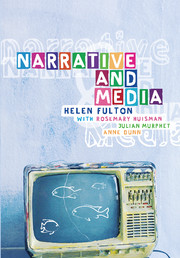Book contents
- Frontmatter
- Contents
- Figures and tables
- Contributors
- Acknowledgements
- 1 Introduction: the power of narrative
- Part 1 The basics of narrative theory
- Part 2 Film as narrative and visual mode
- 4 Stories and plots
- 5 Narrative time
- 6 Narrative voice
- 7 Point of view
- 8 Novel to film
- 9 Film narrative and visual cohesion
- Part 3 Television: narratives and ideology
- Part 4 Radio and print journalism
- Part 5 Popular print culture
- Glossary
- Bibliography
- Index
7 - Point of view
Published online by Cambridge University Press: 05 June 2012
- Frontmatter
- Contents
- Figures and tables
- Contributors
- Acknowledgements
- 1 Introduction: the power of narrative
- Part 1 The basics of narrative theory
- Part 2 Film as narrative and visual mode
- 4 Stories and plots
- 5 Narrative time
- 6 Narrative voice
- 7 Point of view
- 8 Novel to film
- 9 Film narrative and visual cohesion
- Part 3 Television: narratives and ideology
- Part 4 Radio and print journalism
- Part 5 Popular print culture
- Glossary
- Bibliography
- Index
Summary
In previous chapters I have mentioned an important difference between narratives executed through language and those executed through film. We can ‘identify’ readily with verbal narratives because they occur in the very medium in which we ourselves think and speak. When J. D. Salinger's narrator in The Catcher in the Rye writes, ‘I sat in the chair for a while and smoked a couple of cigarettes … Boy, I felt miserable. I felt so depressed, you can't imagine’ (Salinger 1994: 89), the ease of our identification is directly related to the fact that this is exactly how we might describe ourselves. In the case of film, however, we are presented with the products of a technology that is not intrinsic to our comportment in the world. We neither think nor, normally, communicate in celluloid, video or digital imaging. The animated spectacle of a cowboy-doll and a toy space ranger wrestling under the wheels of a semi-trailer in Toy Story (Lasseter 1995) is not a narrative sequence we would be able to execute ourselves; as soon as we represent it, it has entered the realm of language. I have suggested that, to the extent that we are compelled to ‘identify’ with filmic narratives, we are in fact identifying with a series of machines. In some, ‘experimental’ films, such as Michael Snow's La Région centrale (1971), this strange, android identification is explicitly acknowledged – we find ourselves embroiled in the free-wheeling perceptual field of a mechanised camera.
- Type
- Chapter
- Information
- Narrative and Media , pp. 86 - 95Publisher: Cambridge University PressPrint publication year: 2005



